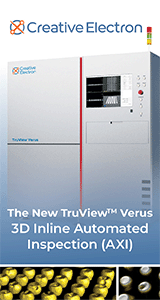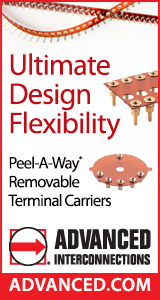|

|
|
|
||||||||
Cause of Damage During Through-hole Component Insertion
Board Talk
|
||||||||
TranscriptPhil Welcome to Board Talk with Jim Hall and Phil Zarrow of ITM Consulting, the Assembly Brothers. Today, we're coming to you from the executive lavatory at ITM headquarters. What's our question today, Jim? Jim This is about automatic insertion of through-hole components, it comes from M.C. During the automatic insertion of two pin components and after clenching the pins, we encounter a small deformation and/or sometimes a small crack in the land or the wall of the plated hole. We need to use a mechanical clenching method per customer's request. These two pin components must sit flat on the PCB with no tilt.What do we do to reduce or eliminate the plated hole damage? What is the criteria for acceptability of cracks and deformations on the plated hole wall? Phil What occurs to me is that you're looking at treating the symptoms rather than the problem with regard to what you might be able to do with adjusting at the board level. From my perspective and looking way back several centuries ago to my experience with auto insertion,it sounds like you've got a problem that needs resolution on your insertion machine. Something like either worn tooling, forming tooling or tooling out of measurement, out of calibration or possibly something wrong with the program. I don't want to state the obvious, but if you haven't done this yet, you probably want to contact the manufacturer of the equipment. Even if it's older, vintage equipment that you bought used, they still support it. I'm assuming you're buying your tooling from them or you should have been or maybe you're overdue as opposed to aftermarket tooling. Insertion equipment is still very vogue, so I would contact them and see what they resolve. Jim I completely agree. Having worked for Dynapert for several years, which manufactured insertion equipment, I could tell you that cut and clench heads are big, heavy, mechanical parts that move really fast and they make a lot of noise. The general description is basically, the heads beat themselves up a lot. They're big, heavy metal heads snapping together to cut and clench the leads and they tend to wear themselves out or get out of adjustment and wear themselves out. They require a lot of maintenance and are very high replacement parts for the tooling. Look at the tooling, talk to somebody who's familiar with this equipment, through technical support. First adjust it correctly and then inspect the tooling to see if those heavy mechanisms might need to be replaced. It was a very significant spare parts system for us because the heads basically just wore themselves out. As far as cracks and deformation on the plated through-hole, that should really be minimal and I would think IPC-610 could give you some guidelines. Cut and place has been around for a very long time and was very successful and was used exclusively before surface mount entered in the 1980s. Obviously it can be done correctly, but those mechanisms do need a lot of attention. Phil The origin of axial insertion was basically a glorified stapler. A company that was building equipment to assemble shoes, the United Shoe Machine Company ultimately became Dynapert. So you had Dynapert and Universal. Universal later acquired Dynapert. Panasonic made insertion equipment, still does, as far as I know. TDK, and believe it or not, Fuji. You've been listening to Board Talk and whether you agree or disagree with Board Talk, hey, we're throwing it out there. When you go to solder those, hopefully no longer to be deformed through-hole joints, whatever you do, don't solder like my brother. Jim And don't solder like my brother. |
||||||||
Comments
|
||||||||
|
|

|




